Blog 6
12th – 16th March
Total Distance – 1106km
This is the last blog for the time being. It has been a long time coming because I have had to postpone the last two-thirds of the expedition until the COVID-19 virus is under control.
La Paz
Days 13 and 14
One of the best things Chris and I did in La Paz was take a ride on the amazing public cable car transport system. It has only been up and running for about two years, but what a fantastic way to get to work – beats the tram, bus and underground systems around the world! The steep, narrow, cobbled streets are very congested with traffic and the cable car system is designed to reduce the number of cars and small taxi busses on the roads. The flip side is that when the cable cars were introduced, many taxi drivers were out of a job because the transition to the new system happened too fast.

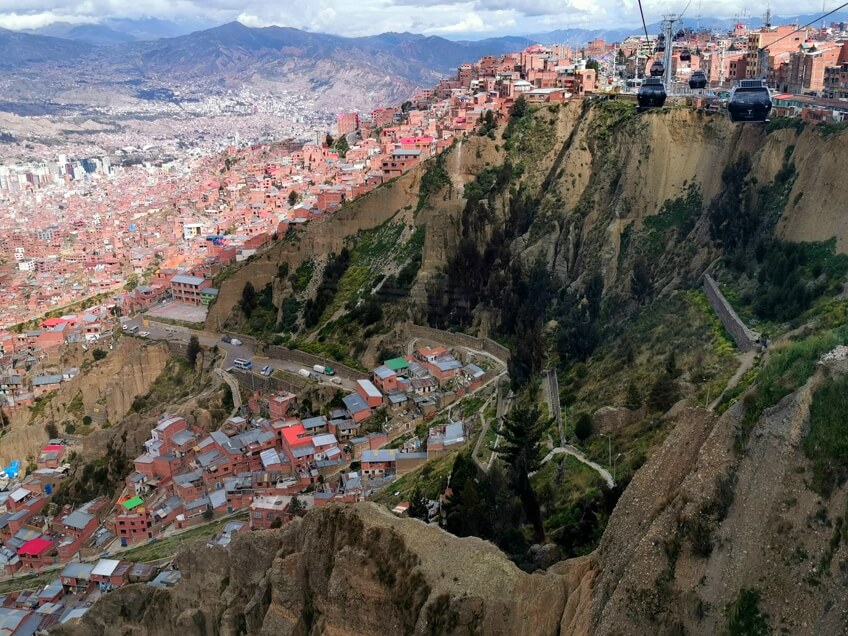
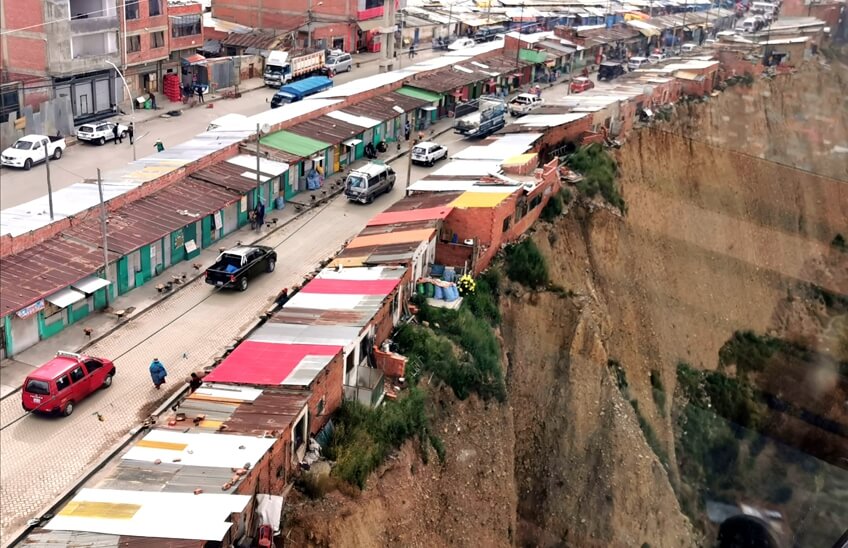
For the rest of the time, Chris, myself and our new driver, Rolando, organised ourselves for the next stage of the journey, a loop into the rainforest through the South Yungas.
Day 15
La Paz – Corioco
Distance – 108km
Pass – 4769m
I rejoined the line of my journey, setting off along the airport road. It was great to be back on the road again, feeling rested from the two-day break. The traffic in the outer suburbs of La Paz was still very hectic and the air horribly polluted, but I just had to ride assertively with the flow.
I decided to take a slightly different course out of town than the usual way to Corioco. Once free of the sprawling city limits, the route proved to be a good choice. Cars were few and far between and I was able to enjoy the high, undulating landscape. After crossing a valley, the road, which was under construction, started to ascend sharply. There were several places where small landslides had blocked or partially blocked the road. It was easy for me to carry my bike over the mud but at one stage, Rolando had to pull the shovel out and dig a path for his vehicle.
The pass was concealed in the clouds at 4769m. It was cold, rainy and the air was very low on oxygen. From there I descended about 150m to the busy Coroico – La Paz road. The road is the main artery dropping away from the Altiplano and into the rainforest. Over the next 30km, I lost 1400m of elevation. Initially, the road and mountains were totally encased in cloud. It was a virtual white-out and I switched my powerful bike headlight on for improved visibility. Rolando drove behind to give me some protection from the heavy traffic. I kept intense concentration to maintain control of my bike in the slippery conditions. Breaking through the mist, the breathtaking scale of the valley and mountains was revealed. I gradually thawed out as I descended into tropical climes.
The main objective for the day was to cycle down Death Road. Prior to 2006, the La Paz – Coroico Road was dubbed the World’s Most Dangerous Road. It is a single-lane stoney, muddy road, that, at times is only about three metres wide. It winds its way from the 4650m Le Cumbre pass (I cycled higher on the first road I followed that morning, before it hit the Coroico Road at the pass) down to the Amazon rainforest. The North Yungas Road, as is its correct name, is cut into a deep canyon with vertical drops of about 600 metres and no side barriers. Normally in Bolivia, drivers and cyclists keep to the right-hand side of the road, but down Death Road, they must stay left, near to the edge of the cliff and give way to vehicles ascending the road.
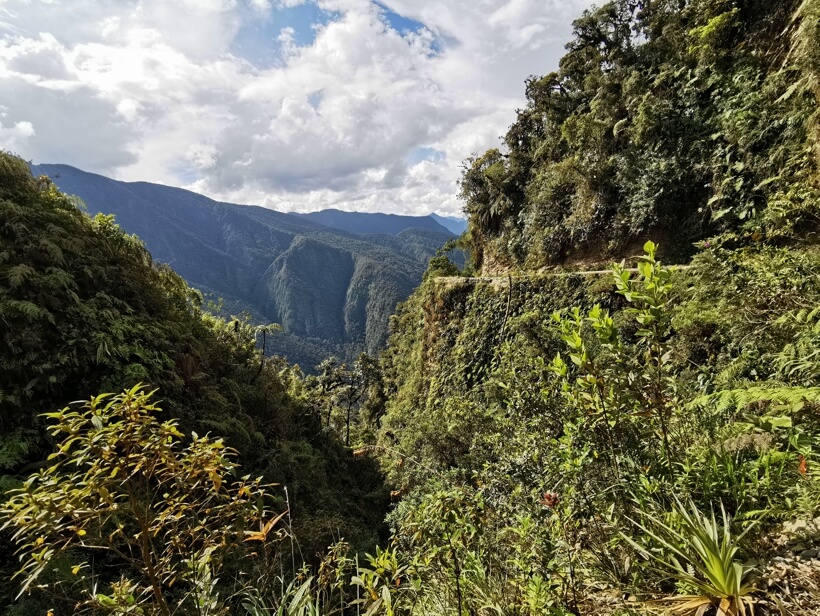
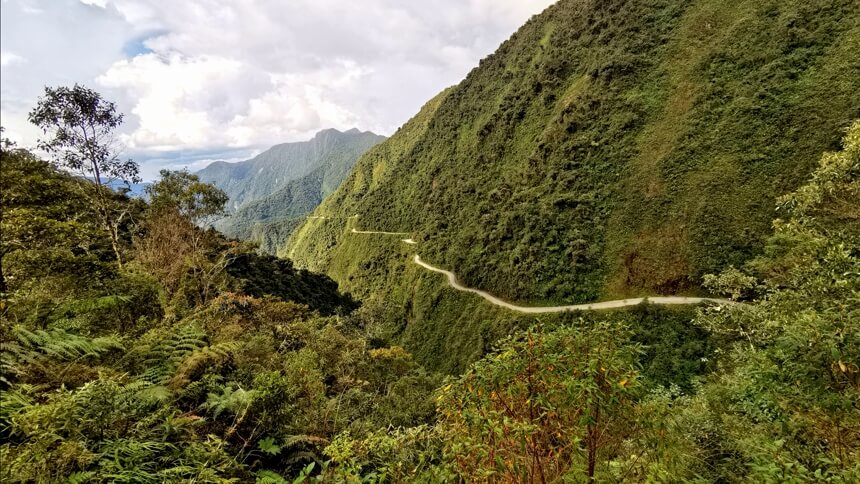
The road was built in the 1930s by Paraguayan prisoners during the Chaco War. Until the 1990s, the road had the most dubious title of the world’s most dangerous road due to the mortality rate. It was estimated that between 200 and 300 people died each year on the road. At the end of 2006, after 20 years of construction, a new bypass road was opened.

These days, Death Road is mostly used as a tourist attraction, especially for cyclists. The very name made me feel wary, but I was intent on enjoying the experience. There isn’t anything like the traffic that there once was and for much of the time I was able to have the road to myself. As far as I am concerned, with a good set of brakes and common sense, cycling the road is an attainable dream for an average cyclist.
In many places, waterfalls shower the path, and anyone who rides or drives it. The vibrant green tropical flora was so different from on the Altiplano – ferns, vines, tall trees and dense ground cover. Colourful butterflies and majestic birds of prey often arrested my attention. The road descended 1100m over about 30km.
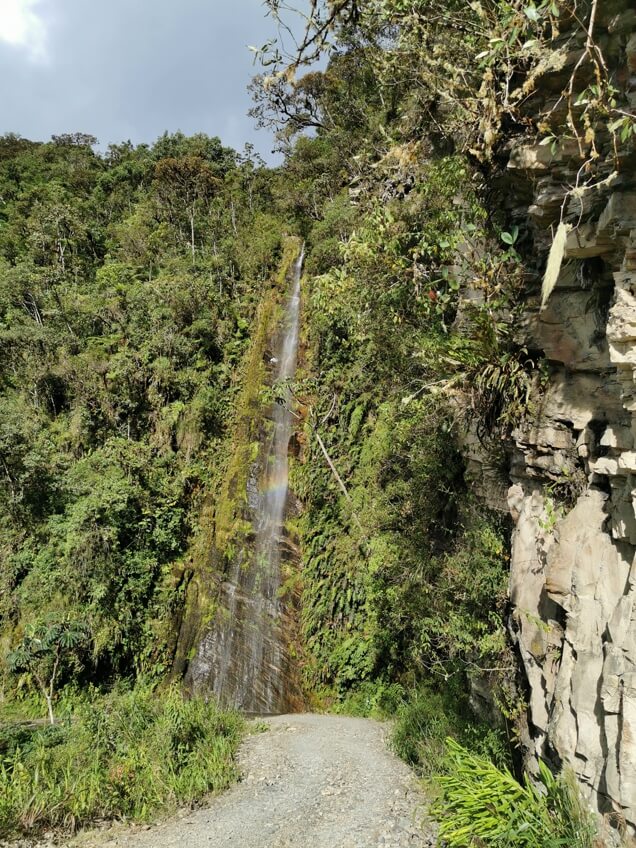
I had done 98km by 6.20pm when I reached a village at the base of the climb. The aim for the day was to make Corioco, an important trading town for the surrounding coffee and coca growers. The town, however, lay on the top of a steep hill, a 9km climb from the bottom of the valley. I knew this would mean I would arrive in the dark but wanted to see if I could reach the destination. The first 4.5km was on a quality paved road, but just as darkness set in, I hit the cobblestones. This was a massive test – the last 4.5km on uneven cobblestones up a steep incline, riding by the vehicle headlights. The road was pretty busy and I struggled to keep the bike on the road and the pedals turning. I made it by about 8pm.
Day 16
Corioco – Chulumani
Distance – 63km
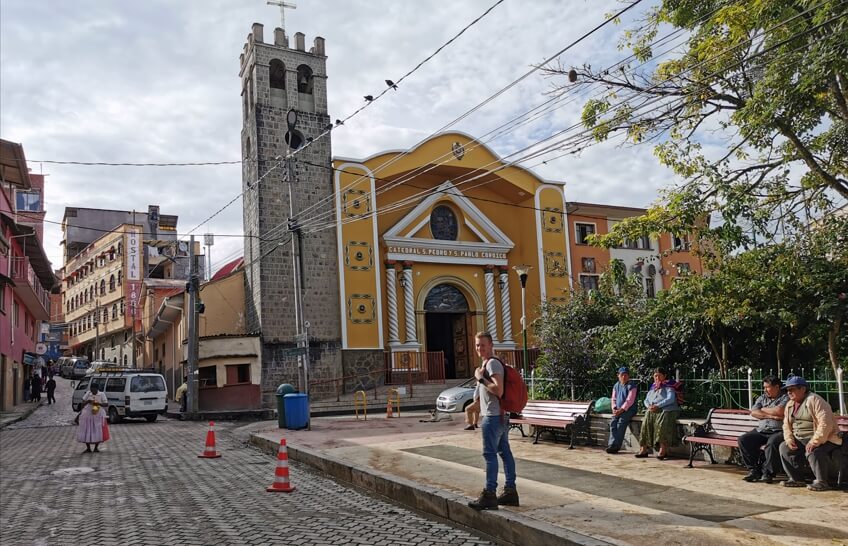
From Coroico, the road tracked the contours of the slope of the Yungas. It was generally up for 300m, then down for 300m, dipping in and out of the spectacular valleys. It was serious work, however, as I was now oscillating between 1100m and 2000m, I found it much easier to breathe and lactic acid didn’t build up in my legs as it had at the higher altitudes. I did suffer from the 90 per cent humidity though.
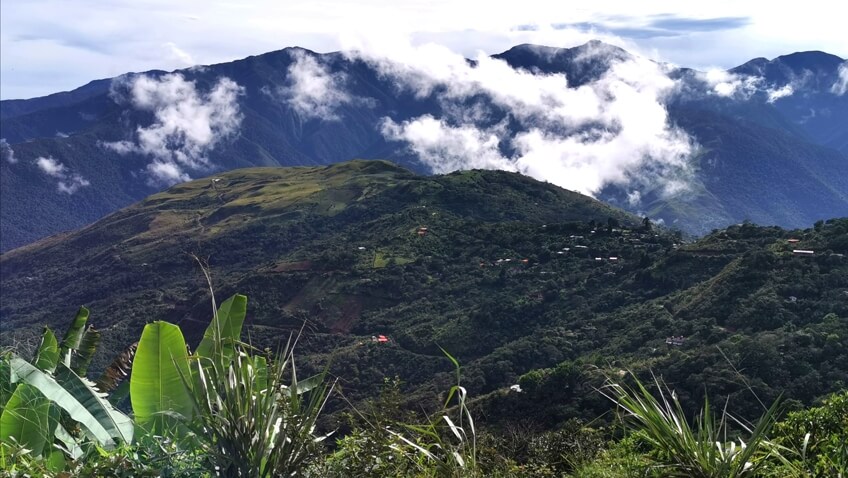
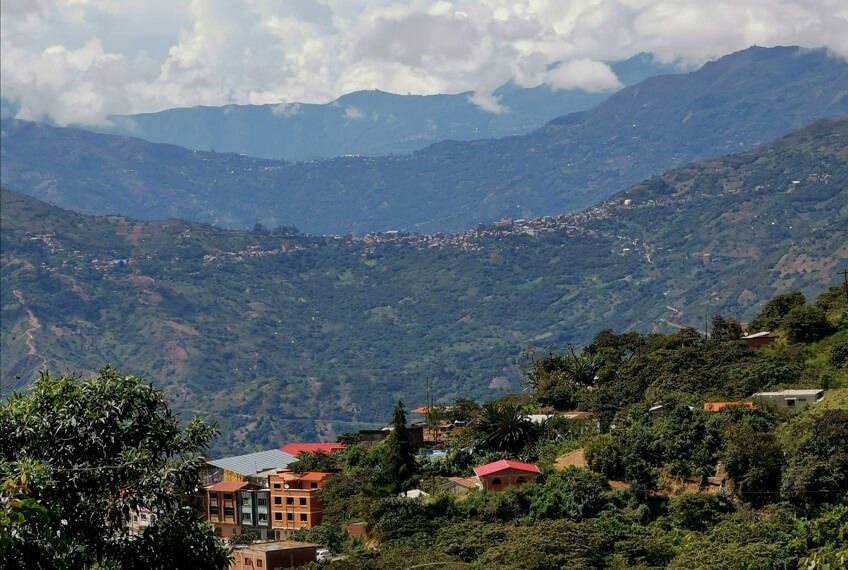
After our lunch break at the village of Coscoma, my Maps.ME app suggested that the fastest route was a secondary road. There was a very steep descent to a fast-flowing river but the climb that followed, about 10km that was mostly steeper than I could handle. The humidity took its toll and the black loose stones radiated more heat. I started to suffer from heat stress. I must have pushed 80 per cent of the way. I had to stop several times to cool down and take in rehydration salts.
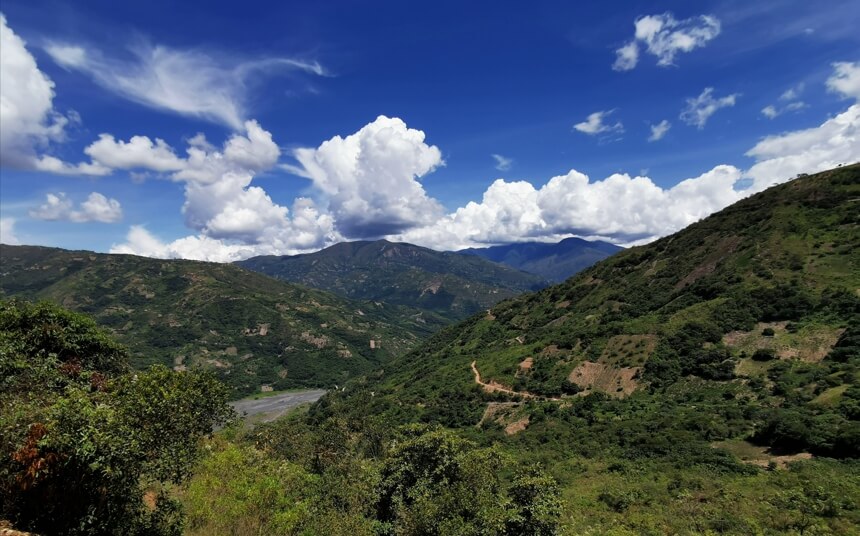
The views were incredible. The locals used even the steepest slopes for production. Whereas I expected to see coffee being grown, as was traditionally the case, these days just about all small producers grow coca leaves for medicinal purposes, as a stimulant and for the black market. Apparently coca leaves are more lucrative than coffee.
Eventually, at a village at the top of the climb, the secondary road connected with the main road and the surface stayed reasonably level for a few kilometres. There were so many mud traps and I often found myself pedalling through a muddy soup. The bike and I were a mess.
We ended up at Chulumani village amidst the town’s annual fair. The main square was packed with people, stalls and a traffic jam. We had difficulty finding a place to stay and there was really only fried chicken to eat for dinner, but that is often the case when travelling freely.
Day 17
Chulumani – Irupana
Distance – 30km
The morning ride to Irupana was as spectacular as it comes; a muddy 5km downhill, then the same distance uphill. This route rivalled Death Road at times, it was just a bit wider and busier. I was still feeling the results of the heat stress from the previous day, so I struggled slowly at times. Irupana lies at 1900m and getting there involved another 800m climb.
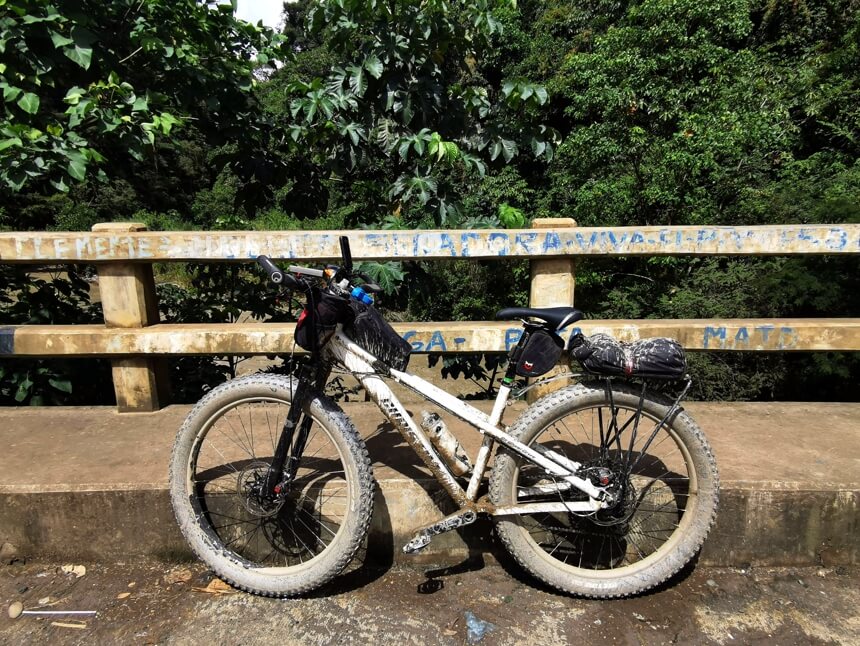
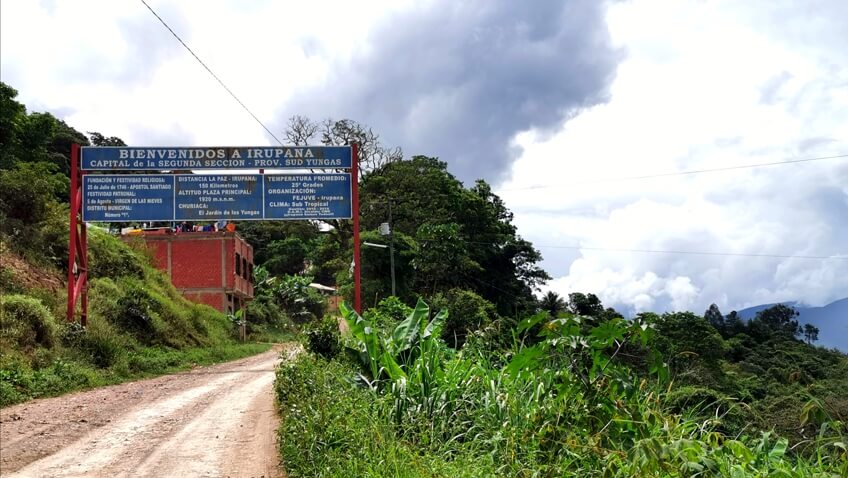
Resting in the village square, the reality of the global situation regarding the COVID-19 virus struck. Argentina and Chile had closed their borders and schools were closed, so there was no way I could achieve the objectives of my journey. I found my own motivation waning because I need to work to the goals that I believe in, in order to put all of my energy into it. I was struggling mentally on this day. Chris and I reasoned the situation through. With a third of the journey completed, I decided to halt the expedition while we could easily return to La Paz.
On the five hour drive back to La Paz, we heard that Qantas was grounding its fleet and most of South America had closed its borders. Just about every hour, there was a new regulation or another restriction imposed. My travel agent, had great difficulties trying to book our return flights. By that night we had a flight reserved on the 20th. We were working to that until the Bolivian government changed the date of its airport closure from the 21st to the 19th March.
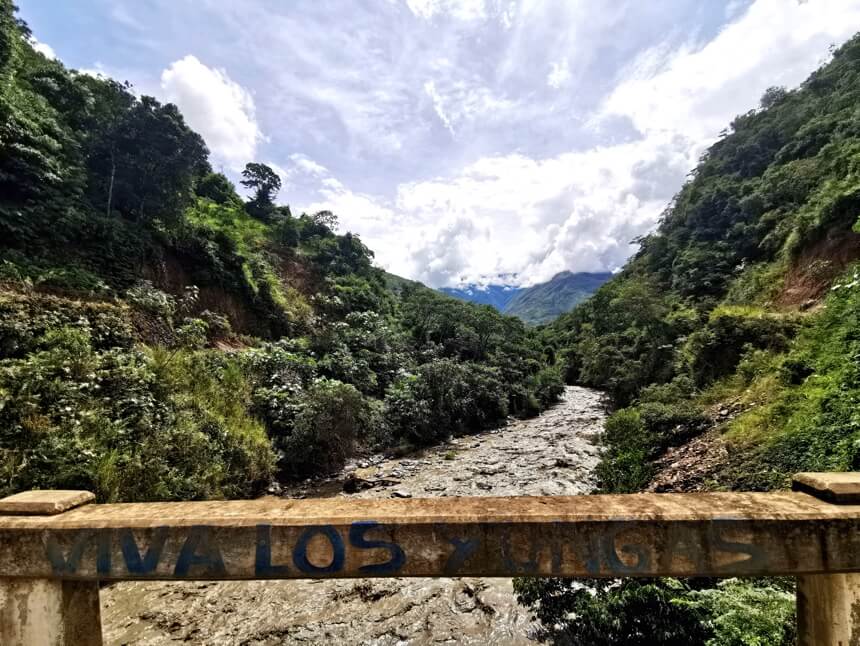
Days 18, 19 and 20
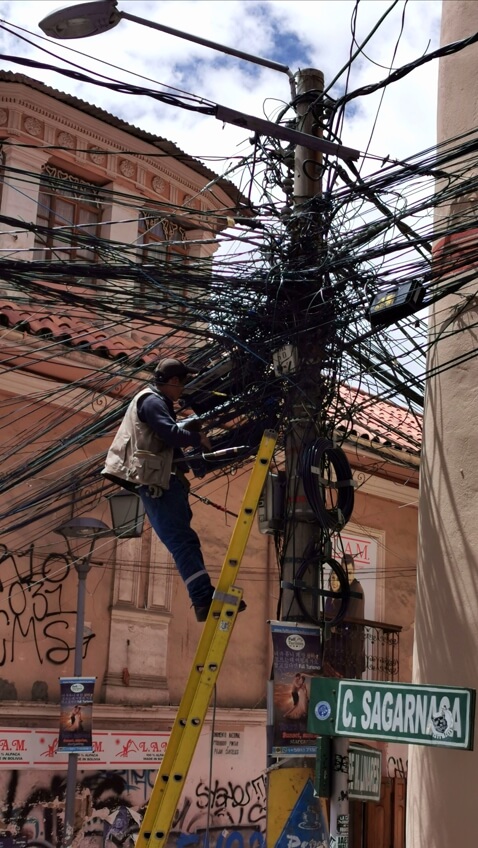
It has been a stressful time trying to find a way home to Australia. A curfew in La Paz was introduced yesterday between 5pm and 5am. Rolando, our driver, waited in La Paz in case we needed his help – and we certainly did. In desperation, Rolando drove us to the airport to see if we could find a flight out. The normally chaotic streets were eerily empty. There were police and military everywhere and we were afraid we would be arrested for breaking the curfew. Even the stray dogs looked baffled as to where all the traffic had gone!
A policewoman questioned us and Rolando explained that we were from the Australian consulate, heading for the airport. She let us go and Rolando did not stop for anything between there and the airport – running every red light and manoeuvring around and through barriers.
The airport visit was fruitless, though I was able to apply for two positions on a special chartered flight to Sao Paulo in Brazil the next day. We returned to the hotel on an equally tension-filled drive. We missed the chartered flight opportunity due to high demand and felt almost resigned that we would be trapped in La Paz once the airport closed.
Our travel agent got to work once more. The only country in South America still open was Brazil, so we had to try to go through Sao Paulo. It was after midnight when an opportunity opened and Colin was able to book us both on the flights. At 3am, Rolando drove us back to the airport. We weren’t stopped this time, but were equally nervous that we could be. This time we were able to board our flight and as I write are on our way back via Santa Cruz, Sao Paulo and Dubai to Melbourne, a trip of more than 50 hours.
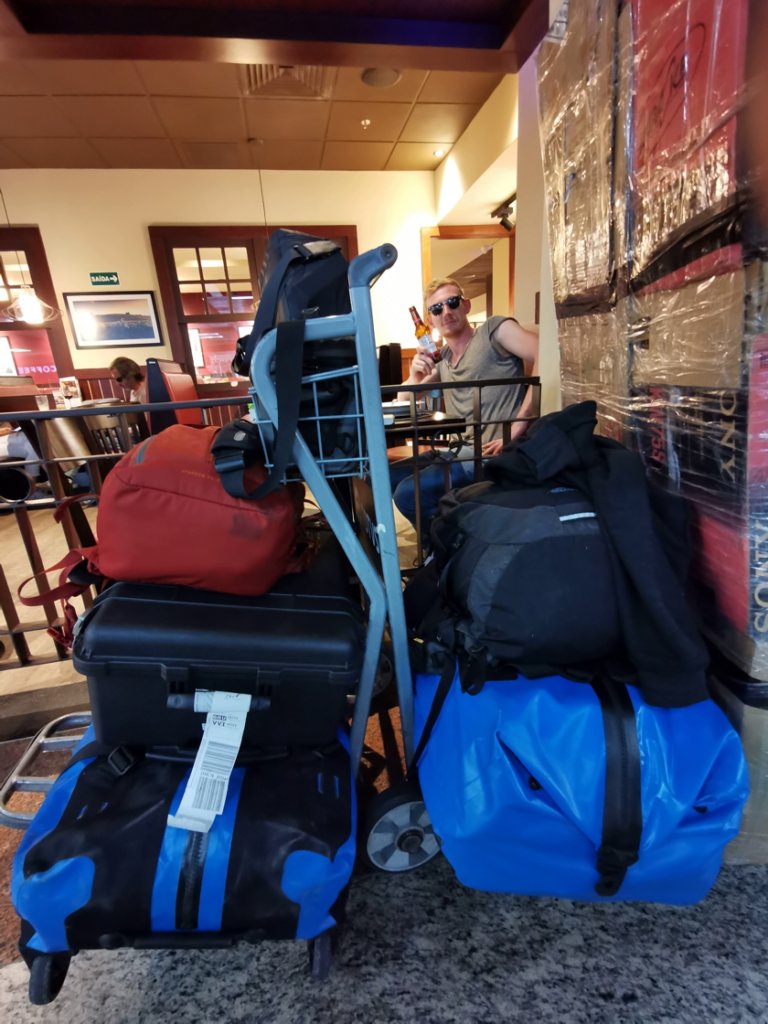









Awesome Kate. My admiration for your adventures and the amazing physical challenges you take gives me chills. Stay safe! John
Great work, Kate
Please advise if you need supplies delivered to your home when self-isolating in Melbourne.
It’ll be good to have you safe.
What a disappointing and frustrating early conclusion for you but we are happy that you are safe and sound and on your way home albeit to self isolation like the rest of us. Keep well! Eric.
Wow! So sorry you had to cut the expedition short. I’ve loved the photos and death road looked incredible. So glad you have managed to get a flight to Australia..good luck with the journey and take care.
Great Expedition. Now time to Stay Safe
Kate,
Reads like an unfinished thriller. Congrats on make git back: join me in self-isolation. Well done so far. Gavan G
Hi Kate.
This blasted virus has got a lot to answer for! I’d wondered how it might impinge on your trip. So frustrating, and just when it looked as though you were entering a really exciting part. Such wonderful photos. So glad you managed to get out, so many folks stranded all over the world.
Enjoy enforced break!!!! Love to the family.
Lindsey.
Hi Kate,
Hope you are safely home by now. Well done for all you achieved for Part 1 of this important expedition. Loved your commentary and photos and the spotlight you are focusing on this part of the world. You are truly an amazing and inspiring adventurer with incredible grit, determination and resilience to deal with multiple simultaneous obstacles. I absolutely admire you and what you have achieved in your life. Looking forward to the 2nd instalment when this pandemic is over.
Leanne